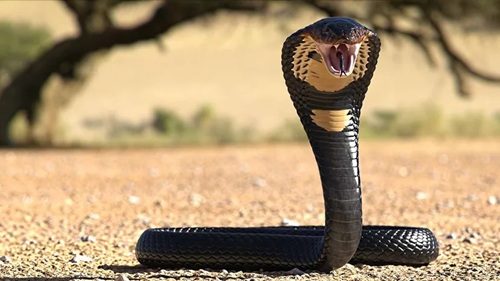India is home to a rich variety of snakes, ranging from non-venomous species to highly poisonous snakes that pose a threat to humans. While snakes generally avoid confrontation, accidental bites can be dangerous, making it essential to identify poisonous snakes for safety and timely medical attention. By observing key physical features, behavior, and habitat, you can distinguish venomous snakes from harmless ones.

1. Common Poisonous Snakes in India
India’s most notorious venomous snakes are often referred to as the “Big Four”, responsible for the majority of snakebite cases:
- Indian Cobra (Naja naja) – Recognizable by its hood and spectacled pattern.
- Common Krait (Bungarus caeruleus) – Slender, shiny black with white bands.
- Russell’s Viper (Daboia russelii) – Heavy-bodied with chain-like patterns.
- Saw-Scaled Viper (Echis carinatus) – Small, aggressive, with a distinctive “sizzling” sound when threatened.
Other venomous species include the king cobra, banded krait, and pit vipers, each with unique features for identification
2. Key Physical Features to Look For
a) Head Shape
- Venomous snakes often have triangular or broad heads compared to non-venomous snakes with slender, rounded heads.
- Exception: Some non-venomous snakes flatten their heads when threatened, so this is not a sole identifying factor.
b) Eyes and Pupils
- Elliptical or slit-shaped pupils are commonly found in venomous snakes like vipers.
- Round pupils are typical of non-venomous species, though cobras are an exception with round pupils.
c) Body Patterns and Coloration
- Many poisonous snakes have distinctive patterns for camouflage and warning:
- Cobra: Spectacle mark on the hood
- Krait: Alternating black and white bands
- Russell’s Viper: Oval or diamond-shaped chain pattern along the back
- Bright or contrasting colors, such as those on pit vipers, may indicate venomous species.
d) Tail and Scales
- Saw-scaled vipers have rough, keeled scales and a short, stubby tail.
- Non-venomous snakes usually have smooth scales and longer, tapering tails.
3. Behavioral Traits
- Defensive Posture: Venomous snakes often raise their head or body, hiss, or spread a hood (cobras) when threatened.
- S-Shaped Coiling: Many vipers coil in an “S” shape ready to strike.
- Sound Warning: Saw-scaled vipers produce a sizzling sound by rubbing their scales together—a clear warning.
4. Habitat Clues
- Cobras and kraits are often found near villages, fields, and water bodies.
- Russell’s vipers prefer grassy plains, farmland, and loose soil.
- Saw-scaled vipers inhabit dry, rocky, or scrub areas.
- Observing the environment and location can provide hints about the likelihood of encountering a poisonous snake.
5. Safety Precautions
- Avoid handling or provoking any snake unless you are trained.
- Wear protective footwear and gloves while walking in forests, fields, or tall grass.
- Educate yourself about local snake species to recognize high-risk snakes in your area.
- Keep a first-aid kit and emergency contact for medical help nearby.
Quick Comparison: Poisonous vs Non-Poisonous Snakes
| Feature | Poisonous Snake | Non-Poisonous Snake |
| Head Shape | Triangular, broad | Rounded, slender |
| Pupils | Elliptical/slit (except cobra) | Round |
| Body Patterns | Distinctive or warning patterns | Uniform or less prominent |
| Scales | Keeled, rough | Smooth |
| Behavior | Defensive posture, hissing, coiling | Usually calm or flees |
| Habitat | Specific to species (fields, rocks, water) | Can inhabit general areas |
Final Thoughts
Identifying poisonous snakes in India relies on observing head shape, pupils, body patterns, scales, behavior, and habitat. While many traits are reliable indicators, it is crucial to treat every snake with caution and avoid direct interaction. Quick recognition and awareness can prevent bites and ensure timely medical intervention, preserving both human and snake safety.